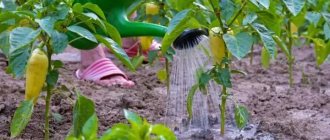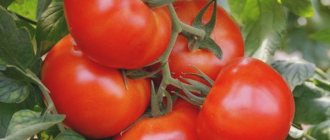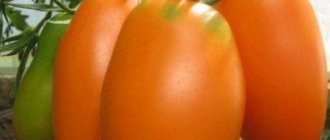Main characteristics and description of the variety
The main difference between the Russian variety “Pink Heart” and other varieties is the large size and heart-shaped shape of the pink fruit. The stems of the plant can reach two meters in height. Warm climate and greenhouse conditions promote active growth. In open soil, tomatoes grow well in warm regions, the height of the bushes reaches 1.5 - 1.7 meters.
The fruits are slightly ribbed, have a rich pink color when ripe, and during the first harvest their weight is 400-500 grams. Subsequent tomatoes weigh 200-300 g. The tomatoes are medium dense, fleshy, and not prone to cracking.
The juicy pulp of the fruit has a sweet taste and is intended mainly for salads. Organic acids and sugar in tomatoes are in an optimal ratio, hence the unique taste of “Pink Heart”.
One plant can produce up to 3 kg of tomatoes with proper care. Three bushes fit on one square meter. From a plot of 1 sq. per meter, from 7 to 9 kg of tomatoes are harvested.
The leaves of the plant are green, large with teeth along the edges, the flowers are small, yellow, simple.
The tomato variety is standard and indeterminate, of medium ripeness, the ripening time of tomatoes is 110 - 120 days from the date of germination of the first shoots.
History of appearance
Pink-fruited tomatoes are loved for their balanced taste, tender flesh, and beautiful appearance. Their selection does not stop, and new varieties of tomatoes appear. The Pink Heart variety is a variety and hybrid of the Bull Heart, which was bred in 2002 by Russian breeders. The following year, it was included in the State Register with a recommendation for cultivation in open ground in the southern regions, in greenhouses and with shelter in the middle zone. The originator of the variety was the Poisk agricultural company.
On a note. The variety has not become widespread, in particular due to difficult care and sensitivity to the growing environment.
Benefits of tomatoes
Tomatoes have thick skin, high sugar content and are resistant to viruses.
Advantages:
- excellent taste;
- high fruit set;
- disease resistance;
- tomatoes do not crack.
Flaws:
- “Pink Heart” tomatoes are heat-loving and in the northern regions they are grown only in greenhouses.
- This large variety produces a small harvest.
- Huge fruits do not fit in a jar, and therefore they are not closed for the winter.
- Vegetables are not stored for a long time; they deteriorate during long transportation.
- Weak branches of plants require a mandatory garter.
- Bushes are capricious to care for.
Video: Pink Heart Tomatoes, review
If you have grown Pink Heart tomatoes, please write whether you liked them or not. What was the yield and taste of the fruits like under your climatic conditions? How do you assess a variety's resistance to disease? Briefly describe the advantages and disadvantages of this tomato in your opinion. If possible, attach to your review a photo of the entire bush as a whole or individual fruits you grew. Thank you!
Your reviews of the Pink Heart tomato and additions to the description will help many gardeners evaluate this variety objectively and decide whether it is worth planting or not.
This is a natural variety of tomato. Therefore, we recommend taking seeds from a ripe fruit and using them for planting in subsequent seasons.
Planting and growing seedlings
The period for planting seedlings of this variety is 60 days from the date of sowing the seed material. Purchased seeds are checked for spoilage before planting.
Tomato seeds are sown in prepared boxes with soil at the beginning of March. The soil composition includes chernozem and peat. The seed material is deepened by 0.5 cm, sprinkled with earth and carefully watered. Covering the containers with film, they are moved to a warm, bright place (temperature +25).
Advice!
To speed up the germination process, it is better to pre-soak the seeds.
The film is removed after germination. The first week the air temperature should be 14-15 degrees, gradually increase it to 23 degrees.
The seedlings are transplanted into individual pots after the plant has three leaves.
Pruning is carried out when the seedlings have grown to 4-5 cm. They are formed into 2 shoots. Removing stepchildren allows the bushes to be planted more densely.
A week before transplanting, the seedlings are hardened off. They are taken out into the fresh air for several hours a day. A couple of days before planting, the three lower leaves of young bushes are cut off; this will protect the tomatoes from diseases.
Two months after sowing the seeds, the seedlings are transferred to a greenhouse or open soil. By this time, young plants already have 8-10 leaves and one inflorescence. A tall plant is planted in a hole, the depth is at least 20 cm. Ash (1 l), humus (1 l) and superphosphate (15 g) are placed in the hole. The seedlings are planted 50 cm apart. 3 bushes are planted per square meter. The holes are covered with mulch.
Nuances of agricultural technology
In March, the seeds are buried in lightly compacted soil, sprinkled with a centimeter layer of peat-soil mixture. After watering the planting with warm water, the container should be moved to a bright place and the temperature should be maintained within +25 ᵒC.
As soon as the first shoots appear, remove the film from the container and place the seedlings in a well-lit place. For the first 7–8 days, the air temperature should not be too high and exceed +15–16 ᵒС, and later it can be increased to 20–22 ᵒС. As soon as 1-2 true leaves appear, you can pick.
Plants are transferred to their permanent place of residence when they reach the age of 60–65 days. Moreover, they should already have 6–7 true leaves and at least one flower cluster.
Judging by the reviews of those who planted, the tomatoes set fruit well and ripen well. They have special requirements for temperature and watering and are very fond of complex fertilizing.
Disease resistance is average - a lot will depend on care. In particular, by creating favorable conditions for lighting, air circulation, watering and loosening, it is possible to increase resistance to late blight, fungal diseases, brown rot, and pests.
If any of them manifest themselves, it is necessary to eliminate all unfavorable factors and, if necessary, apply insecticides, for example, “bison”, “hom”, “arrow”, etc. Excess tops must be removed and the soil must be isolated.
As practice shows, plants are rarely affected by cladosporiosis, TMV, and Alternaria leaf spot. So if you want to take a risk and try something new, go for it. Having experience in growing tomatoes, you will succeed, I am sure of it.
Well, beginners should start with something less capricious. Have a good harvest everyone and don’t forget to tell your friends and acquaintances about what you learned. Good luck!
Rules of care
The bushes have weak side shoots and are tall, so they need supports and a garter. To increase the yield, plants need to be shaped.
Water the tomatoes regularly, but in moderation. Young bushes are watered more often.
Attention!
If the leaves begin to curl, it means the plant does not have enough moisture.
The first fertilizing is added to the soil three weeks after the seedlings are transferred to the garden. Ingredients: potassium chloride 10 g, superphosphate 50 g. The second time, fertilizers are applied during the formation of the first ovaries: potassium nitrate 20 g and liquid superphosphate 80 g. The bushes are fertilized with the same composition during the period of fruit ripening (two feedings).
Don’t forget to weed the weeds around the seedlings.
Alsou
Determinate hybrid for “lazy” gardeners. A low-growing variety adapted to harsh climates. The pink fruits look like huge buds weighing half a kilogram or more.
From the first shoots to ripening – 90 days. Fruits with dense pulp have a classic tomato taste and are absolutely universal in use - perfect for both winter harvesting and fresh consumption.
Disadvantage: despite the fact that the plant does not need to be tied up, it requires quite painstaking care, since Alsou is more susceptible to various diseases than its “relatives,” including blossom-end rot. But with proper care and feeding, you can get more than 4 kilograms of delicious tomatoes from one small bush.
Disease resistance
The Pink Heart variety is disease resistant, but brown rot fungus can harm plants. If the bush is completely damaged by the fungus, it is removed and burned. Applying nitrogen and removing damaged foliage will help prevent infestation. Melon aphids are removed using the preparation “Zubr”. Scattered ash helps against slugs.
By following a few rules of prevention, you can avoid unnecessary problems:
- spray the bushes with special preparations once every 10 days;
- disinfect the greenhouse and tools;
- ventilate the greenhouse;
- correct watering mode;
- mulching around the holes with hay, dry grass, sawdust;
- timely fertilizing will strengthen the plant’s immunity.
Possible diseases and pests
Tomatoes have good immunity to fungal diseases. But brown rot may appear on tomatoes. It is necessary to eliminate diseased fruits and stop adding nitrogen, and spray the bushes with the preparation “Hom”.
If the bushes are attacked by slugs, then you need to cut off the tops and scatter the ash on the ground.
This tomato variety produces large, pink-colored fruits and is quite demanding when it comes to watering and fertilizing, so it is best grown by experienced gardeners.
In general, “Pink Heart” is a fairly strong and disease-resistant variety with good immunity. However, brown rot may appear on the fruit. In this case, it is imperative to remove the diseased tomatoes from the bush. For treatment, the bushes should be treated with Hom.
In fairly rare cases, plant leaves can be infested by aphids. To get rid of the pest, you can use the preparations “Bison” or “Strela”.
As a preventive measure against a possible attack by slugs, stove ash can be scattered in the root zone of plants. It is advisable to remove the lower tops of the bush.
“Pink Heart” has average resistance to diseases. The most common diseases are late blight, brown rot, white rot, powdery mildew, verticillium, and cladosporiosis. The health of the plant depends on its care. When any disease manifests itself, it is worth removing all provoking factors. Collect and destroy diseased parts. Antifungal and antiviral drugs are also used.
It was for this variety that selectors created resistance to macrosporiosis, brown spot and tobacco mosaic virus.
The variety “Bull's heart pink” is resistant to late blight. However, he is not immune to other diseases. It can be attacked by fungal rot in the presence of high humidity.
READ MORE: DIY support for clematis photo ideas interesting design
Gray rot is manifested by the formation of brown spots on the leaves and stems, covered with a fluffy gray coating. All affected areas must be cut off immediately, leaving only healthy tissue. Treat the bushes with systemic fungicides (Skor, Ordan, Fundazol, Previkur) or copper preparations.
Brown spot (cladosporiosis). Yellow spots of various sizes appear on the surface of the leaves, which gradually grow and the leaves fall off. Then the flowers and fruits begin to dry out. For prevention, seeds are treated with Bravo, and infected plants with copper preparations.
Aphids are one of the main pests that attack tomatoes. Small green insects settle on the inside of leaves and greatly slow down the development of plants. To get rid of them, it is necessary to treat all plantings with insecticides such as Confidor, Akarin, Decis.
Cotton and tomato bollworms. Inconspicuous-looking adult butterflies do no harm. The leaves are actively eaten by their caterpillars. Actofit, Zolon, Decis Profi, Karate will help in pest control.
“Bull's heart pink” is an excellent variety of tomatoes for universal use, with virtually no drawbacks. It is characterized by high yield, resistance to diseases and pests, and excellent taste.
If you find an error, please highlight a piece of text and press Ctrl Enter.
Variety Velmozha
A tomato with a Siberian “character”. Bred in Altai, in Novosibirsk, it prefers a cool climate to the warmth usual for nightshades.
Despite the fact that the variety is determinate (the bushes are no more than half a meter high), the stem will have to be tied to a support: on the weak stem, rather heavy (up to half a kilogram or more) beautiful heart-shaped fruits of a rich crimson color grow.
The indispensability of Velmozhi lies in its ease of care (it is grown without any shelter), Siberian immunity to diseases and pests, and its amazing, almost dessert taste.
The downside is that the fruits do not last long and, upon reaching maturity, quickly begin to crack. However, they won’t be able to be stored for a long time in any case - such a delicacy is eaten first at the summer table!
Japanese crab
Another achievement of Siberian scientists. An indeterminate medium-growing variety that produces fruits from July to September. The fruits are formed on the stem in layers - replacing already ripe ones. Weight varies from 250 to 800 g.
Funny-shaped ribbed tomatoes have an amazing sweet taste. The yield is no less pleasing - up to 12 kg per bush.
Japanese crab is resistant to late blight and other diseases, and easily tolerates temperature changes. The only drawback is the impossibility of whole-fruit harvesting for the winter due to the large size of the fruit.
Variety of pink tomatoes - Demidov
A classic of the tomato genre. With maximum unpretentiousness - a consistently high yield in any climate. Gardeners grow it under the motto “Plant and forget.”
A very beautiful bush with a powerful stem (60-70 cm) and carved dark green foliage. Small fruits of a neat round shape literally sprinkle the bush with fruits: from 1 sq.m. you can collect 10-12 kg of tomato delicacy.
The main advantage of Demidov over its brethren is that it can ripen after being picked from a branch, without losing its taste. By properly packing the green fruits into boxes, you can enjoy fresh tomatoes until the end of November!
Medium-sized fruits are ideal for whole-fruit canning.
The disadvantages of tomatoes include the tendency to crack the fruits in the absence of moisture for a long time and damage by blossom end rot if the soil dries out. At the same time, Demidov is very resistant to all other nightshade diseases.
Pink Elephant
One of the best tomatoes in Russia. A medium-sized, mid-ripening variety (about one and a half meters) of domestic selection, bearing fruit from the end of July until frost.
The fruits are juicy, slightly sour, and contain large amounts of potassium and fiber. On average, they are small in size and weight: 150-250 g, on the lower branches they can reach a kilogram.
Despite the thin skin, tomatoes can be stored for up to a month after harvesting, do not crack and are irreplaceable for fresh consumption.











